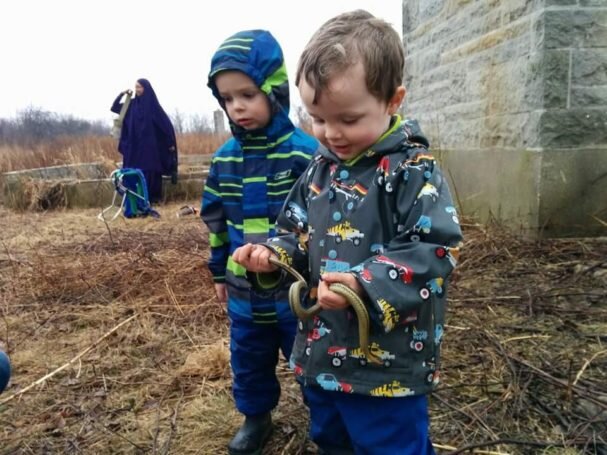WILD CHILD: Encouraging Kindness in Nature
Recently we found snakes during Wild Child playgroups. The children very gently held the snake, letting it slip through their hands never squeezing or dropping it, and carefully put it back in the grass after playing with it because it seemed agitated. That moment epitomizes what I wish for all children when I they play outside in the wild places. A sense of respect, a sense of curiosity, and a sense of gentleness and kindness towards other living creatures while observing and interacting comfortably with those creatures.
These are a few strategies we’ve used to support more thoughtful and careful interactions with nature in children:
Ask a lot of questions. Do you think the frog is scared? How can we make sure the frog stays safe? If the frog fell do you think it would get hurt? What do frogs need to be happy? (In this case it was NOT a plastic lunch container with picked grasses and dirty stream water).
Model the behavior. Especially in new situations, we watch those around us for cues about how to behave. If I look closely at the wild garlic, gently rub the leaves, and smell my fingers, and step carefully avoiding the new growth, my children will mimic me. By showing them how I can investigate and observe a plant or creature in depth without damaging or hurting it, I give them new tools to use as they explore. They may still pull up or pick the plants but that leads to the next tip.
Discuss the consequences. For children, it isn’t obvious that a picked flower can’t grow anymore. That means other people and children can’t enjoy its beauty, the bees can’t use it for food, and it won’t be able to make seeds to grow new flowers to enjoy next year. If we eat all the raspberries, what will the birds and animals that need them for food eat? Even better, change “don’t do” to “let’s help”, and show children how to protect an animal (maybe helping snails across the path on a rainy day) or plant the seeds of a native plant to encourage new growth and habitat for other species.
Finally, provide a way to retell the adventure. I have noticed that usually when children pick a plant it is because they wanted to show me or someone else their discovery, not damage the plant. Offering to take a picture, or having a small notebook for drawing a picture of what they see can help fill that need. It also encourages them to retell their stories, sharing the experience and the learning with others.
Encouraging a sense of kindness and respect for nature can be as simple as helping them to realize that that animal or mini beast is another living being. Children seem to naturally want to care for the creatures and plant life they recognize; and if we give them the tools to do so, they will exceed our expectations, paving the way to good stewardship of their environment as they grow.
Written by Tandy Morton, WILD CHILD Playgroup Facilitator





